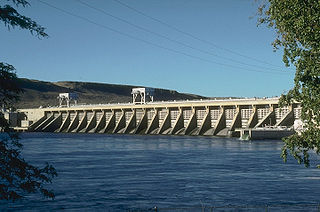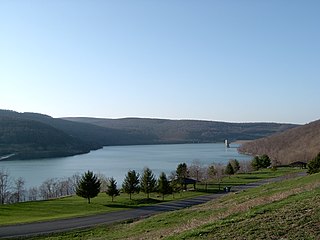Related Research Articles

The Columbia River is the largest river in the Pacific Northwest region of North America. The river forms in the Rocky Mountains of British Columbia, Canada. It flows northwest and then south into the U.S. state of Washington, then turns west to form most of the border between Washington and the state of Oregon before emptying into the Pacific Ocean. The river is 1,243 miles long, and its largest tributary is the Snake River. Its drainage basin is roughly the size of France and extends into seven states of the United States and one Canadian province. The fourth-largest river in the United States by volume, the Columbia has the greatest flow of any river entering the Pacific outside of Asia, and the 36th greatest discharge of any river in the world.

The United States Army Corps of Engineers (USACE) is a direct reporting unit and engineer formation of the United States Army that has three primary mission areas: Engineer Regiment, military construction, and civil works. The day-to-day activities of the three mission areas are administered by a lieutenant general known as the chief of engineers/commanding general. The chief of engineers commands the Engineer Regiment, comprising combat engineer, rescue, construction, dive, and other specialty units, and answers directly to the Chief of Staff of the Army. Combat engineers, sometimes called sappers, form an integral part of the Army's combined arms team and are found in all Army service components: Regular Army, National Guard, and Army Reserve. Their duties are to breach obstacles; construct fighting positions, fixed/floating bridges, and obstacles and defensive positions; place and detonate explosives; conduct route clearance operations; emplace and detect landmines; and fight as provisional infantry when required. For the military construction mission, the chief of engineers is directed and supervised by the Assistant Secretary of the Army for installations, environment, and energy, whom the President appoints and the Senate confirms. Military construction relates to construction on military bases and worldwide installations.

Rocky Reach Dam is a run-of-the-river hydroelectric dam in the U.S. state of Washington owned and operated by Chelan County Public Utility District. It has 11 generators rated in total 1300 MW. The project is on the Columbia River in north central Washington state about seven miles (11 km) upstream from the city of Wenatchee. The dam is 473 miles (761 km) above the mouth of the Columbia. The reservoir impounded by the dam is Lake Entiat. The project provides energy for more than 7 million people throughout the Pacific Northwest.

Wanapum Dam is a run-of-the-river hydroelectric project located on the Columbia River downstream (south) from Vantage, Washington where Interstate 90 crosses the Columbia from Grant County into Kittitas County. It is owned by the Grant County Public Utility District. Its reservoir is named Lake Wanapum.

Priest Rapids Dam is a hydroelectric, concrete gravity dam; located on the Columbia River, between the Yakima Firing Range and the Hanford Nuclear Reservation, and bridges Yakima County and Grant County, in the U.S. state of Washington. The dam is 24 miles south of the town of Vantage, and 47 miles northwest of the city of Richland. It is located at mile marker 397.1 from the mouth of the Columbia. It is owned by the Grant County Public Utility District (PUD). Priest Rapids, for which the dam was named, are now submerged beneath the dam's reservoir.

McNary Dam is a 1.4-mile (2.2-km) long concrete gravity run-of-the-river dam which spans the Columbia River. It joins Umatilla County, Oregon with Benton County, Washington, 292 miles (470 km) upriver from the mouth of the Columbia. It is operated by the U.S. Army Corps of Engineers' McNary Lock and Dam office. The dam is located a mile (2 km) east of the town of Umatilla, Oregon, and 8 miles (13 km) north of Hermiston, Oregon. The dam was originally planned to be named Umatilla Dam, but the Flood Control Act of 1945 renamed the dam in honor of Senator Charles L. McNary of Oregon, who had died the previous year.

District of Columbia home rule is the District of Columbia residents' ability to govern their local affairs. As the federal capital, the Constitution grants the United States Congress exclusive jurisdiction over the District in "all cases whatsoever".

Jennings Randolph Lake is a reservoir of 952 acres (3.85 km2) located on the North Branch Potomac River in Garrett County, Maryland and Mineral County, West Virginia. It is approximately 8 miles (13 km) upstream of Bloomington, Maryland, and approximately 5 miles (8.0 km) north of Elk Garden, West Virginia.
In the United States, there are multiple laws known as the Flood Control Act (FCA). Typically, they are enacted to control irrigation because of floods or other natural disasters and are administered by the United States Army Corps of Engineers. These laws were enacted beginning in 1917, with the most recent one being passed in 1965.

Isabella Dam is an embankment dam located in the Kern River Valley, about halfway down the Kern River course, between the towns of Kernville and Lake Isabella in Kern County, California.
Energy Northwest is a public power joint operating agency in the northwest United States, formed 66 years ago in 1957 by Washington state law to produce at-cost power for Northwest utilities. Headquartered in the Tri-Cities at Richland, Washington, the WPPSS became commonly known as "Whoops!", due to over-commitment to nuclear power in the 1970s which brought about financial collapse and the second largest municipal bond default in U.S. history. WPPSS was renamed Energy Northwest in November 1998, and agency membership includes 28 public power utilities, including 23 of the state's 29 public utility districts.
Water supply and sanitation in the United States involves a number of issues including water scarcity, pollution, a backlog of investment, concerns about the affordability of water for the poorest, and a rapidly retiring workforce. Increased variability and intensity of rainfall as a result of climate change is expected to produce both more severe droughts and flooding, with potentially serious consequences for water supply and for pollution from combined sewer overflows. Droughts are likely to particularly affect the 66 percent of Americans whose communities depend on surface water. As for drinking water quality, there are concerns about disinfection by-products, lead, perchlorates, PFAS and pharmaceutical substances, but generally drinking water quality in the U.S. is good.

Optima Lake was built to be a reservoir in Texas County, Oklahoma. The site is just north of Hardesty and east of Guymon in the Oklahoma Panhandle.
The Water Resources Development Act of 1986 is part of Pub. L.Tooltip Public Law 99–662, a series of acts enacted by Congress of the United States on November 17, 1986.
Rivers and Harbors Act may refer to one of many pieces of legislation and appropriations passed by the United States Congress since the first such legislation in 1824. At that time Congress appropriated $75,000 to improve navigation on the Ohio and Mississippi rivers by removing sandbars, snags, and other obstacles. Like when first passed, the legislation was to be administered by the United States Army Corps of Engineers (USACE), under its Chief Engineer and the Secretary of War.
Water Resources Development Act of 1988, Pub. L.Tooltip Public Law 100–676, is a public law passed by Congress on November 17, 1988 concerning water resources in the United States in the areas of flood control, navigation, dredging, environment, recreation, water supply, beach nourishment and erosion.

Mossyrock Dam is a concrete arch-gravity dam on the Cowlitz River near Mossyrock in Lewis County, Washington, United States. The reservoir created by the dam is called Riffe Lake. The primary purpose of the dam is hydroelectric production while flood control is a secondary function. The dam is the tallest in Washington state and its hydroelectric power station supplies 40% of Tacoma Power's electricity.

The Snohomish County Public Utility District is a public utility agency providing power to over 367,000 customers in Snohomish County and on Camano Island, Washington. It provides water service to about 23,000 customers in the northeast section of the Snohomish County.

The Portland District is one of the five districts within the Northwestern Division of the United States Army Corps of Engineers. The Portland District is made up of some 1,100 civilian and 6 military personnel.

The 1948 Columbia River flood was a regional flood that occurred in the Pacific Northwest of the United States and Canada. Large portions of the Columbia River watershed were impacted, including the Portland area, Eastern Washington, northeastern Oregon, Idaho Panhandle, northwestern Montana, and southeastern British Columbia. A publication of the U.S. Geological Survey in 1949 stated property damage reached $102.7 million, 250,000 acres of farmland were flooded, 20,000 acres of land were damaged or destroyed, and at least 16 died in the flood ; estimates for total deaths from the flood go as high as 102. Among the damage was the complete destruction of Vanport, in the Portland metropolitan area, which was the second largest city in Oregon at the time. The flood was largely caused by rapid melting of above-average snowpack by heavy precipitation and warm temperatures. It remains the second largest flood recorded on the river.
References
- ↑ "Public Law 516-81st Congress" (PDF). U.S. Fish & Wildlife Service. Retrieved March 15, 2020.
- ↑ Columbia River Treaty: History and 2014/2024 Review (PDF) (Report). Bonneville Power Administration and the U.S. Army Corps of Engineers. April 2008. Archived from the original (PDF) on June 4, 2011.
- ↑ Priest Rapids Hydroelectric Project No. 2114 Public Utility District No. 2 of Grant County Final Application for New License, Exhibit B: Project Operation and Resource Utilization (PDF) (Report). October 2003. Archived from the original (PDF) on 2013-01-17. Retrieved 2008-10-05.

